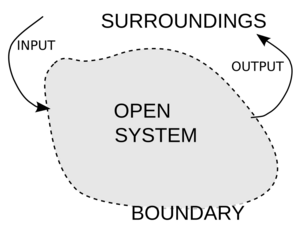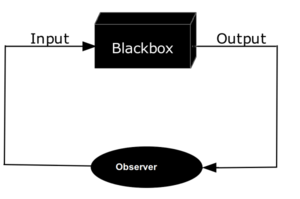Black box facts for kids
Imagine a mystery box. You can't see what's inside, but you can put things into it (inputs) and see what comes out (outputs). In science, computers, and engineering, a black box is like this mystery system. You only know what goes in and what comes out, without needing to understand how it works inside. It's "black" because its inner workings are hidden.
This idea can describe many things, like how a computer program works, how an engine runs, or even how your brain processes information.
The opposite of a black box is a white box (sometimes called a "clear box" or "glass box"). With a white box, you can see and understand all its inner parts and how they work.
Contents
The History of the Black Box Idea
The term "black box" became popular in English around 1945. In the world of electronics, engineers like Wilhelm Cauer started thinking about circuits as black boxes. They focused on how signals went in and how they came out, without always needing to know every tiny detail of the circuit's design.
Later, in the 1950s and 1960s, scientists like Ross Ashby and Norbert Wiener used the black box idea in a field called cybernetics. Cybernetics is about how systems control themselves and communicate. They saw the black box as a way to understand unknown systems by just looking at their inputs and outputs. Many other experts, like Mario Bunge, also helped develop this theory.
Understanding Systems with a Black Box

In systems theory, a black box is a way to think about a system that you can only observe from the outside. You see what goes in (the "stimuli inputs") and what comes out (the "output reactions").
As scientist Mario Bunge explained, "The inside of the box doesn't matter for this way of looking at things. We only care about what the system does."
The main idea behind understanding a black box is to guess the "cause and effect." This means we assume there's a reason why a certain input leads to a certain output. The input and output are different, you can see them, and the system itself is hidden from you.
Watching What Happens
To study a black box, an observer watches it over time. They write down everything they see: what goes into the box and what comes out.
For example, imagine you find a strange box from a flying saucer. You might write down:
| Time | What I did and what the Box did |
|---|---|
| 11:18 | I did nothing—the Box made a steady hum. |
| 11:19 | I pushed the switch marked K: the hum got higher and stayed steady. |
| 11:20 | I accidentally pushed the button marked “!”—the Box got warmer. |
| ... | And so on. |
This list of observations is called a "protocol." All the information you can get about a black box comes from this protocol. You can rearrange it or look at it in different ways, but that's all the information you have.
If you can also control what goes into the box, you are doing an experiment. This helps you test your ideas about what causes what.
Creating a Model
When you have a lot of observations, you can try to build a "model." A model is like a prediction tool. It uses the information you've gathered to guess what the black box will do next when you give it a new input.
Testing Your Black Box Model
Once you have a model, you need to test it. This is called "black-box testing." You use new information (data you haven't used before) to see if your model correctly predicts the outputs. If it does, your model is good!
Other Ways to Use the Black Box Idea
The idea of a "black box" can be used in many areas, not just science. It applies whenever you look at how a system works based only on what you can see from the outside, without trying to explain the hidden reasons inside. For example, Isaac Newton's theory of gravity was a bit like a black box theory. He described how gravity worked (what it did), but he didn't explain exactly *why* it worked that way.
The black box idea is useful when you don't have all the information about something. You know what goes in and what comes out, but the middle part is a mystery.
In Understanding People
In subjects like philosophy and psychology, the black box idea helps us understand human behavior. For example, when companies study how people decide to buy things (consumer behavior), they often treat the human mind as a black box. They look at what influences people (inputs) and what they buy (outputs), without fully knowing every thought process inside.
Everyday Black Boxes
The black box idea is even useful in our daily lives:
A child trying to open a door has to move the handle (the input) to make the latch move (the output). They learn how to control the handle to open the door without being able to see the hidden parts inside. In our daily lives, we often deal with systems whose insides we can't fully see, and we have to treat them like black boxes.
...The human brain is certainly a Black Box, and while a great deal of research is going on to understand the brain, progress in treatment is also being made by observing patients' responses to what they are given.
How Black Boxes Are Used

In Computers and Math
- In computer programming, black box testing is a way to check if a program works correctly. Programmers give the program certain inputs and check if the outputs are what they expect. They don't look at the actual code inside the program, just like looking at a black box.
- A "black box program" can also mean a program where you can't see the code (like a secret recipe) or one that works perfectly on its own without causing any problems.
- Sometimes, a company might give you a piece of equipment that they manage and support. You just use it, and you don't need to worry about how it works inside. This is also called a black box.
In Science and Technology
- In artificial intelligence (AI) or "learning" computers, a black box can describe parts of the program that are constantly changing and hard for programmers to test directly.
- In physics, a black box is a system whose inner structure isn't known, or doesn't need to be known for a specific purpose.
- In cryptography (the science of secure communication), black boxes help explain how information is kept secret, even when parts of a process are shared.
Other Uses
- In philosophy and psychology, the idea of behaviorism treats the human mind as a black box. This means they focus on how people react to things they experience, rather than trying to understand every thought inside their heads.
See also
 In Spanish: Caja negra (sistemas) para niños
In Spanish: Caja negra (sistemas) para niños
- Black box group
- Blackboxing
- Chinese room
- Flight recorder
- Grey box model
- Hysteresis
- Open system:
- in (general) Systems theory
- in Thermodynamics
- in Control theory
- Multi-agent system
- Prediction/Retrodiction
- Related theories
- Oracle machine
- Pattern recognition
- Systems theory
- Signal processing
- System identification
- Stimulus–response model



